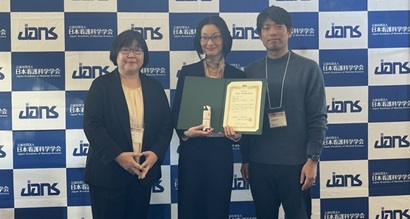JIU Josai International University

Professor Kitada's Research won the Excellent Presentation Award at the 44th Japan Academy of Nursing Science Academic Conference
teaching activity
2024.12.25
Professor Kitada's Research won the Excellent Presentation Award at the 44th Japan Academy of Nursing Science Academic Conference.

From the left: Assistant Professor Tateno, Professor Kitada, and Associate Professor Kabashima
The Research group of Professor Motoko Kitada of Faculty of Nursing Department of Nursing (Professor Ayako Ninomiya, Associate Professor Minoru Kabashima, Assistant Professor Kazuko Tateno) received the Outstanding Oral Presentation Award at the 44th Japan Academy of Nursing Science Academic Conference. The Outstanding Oral Presentation Award is given to oral presentations that are expected to contribute greatly to the development of nursing science.
Professor Kitada presented a paper entitled "The Actual State of Peripheral Venous Catheter Placement in Elderly Hospitalized Patients" at the 44th Japan Academy of Nursing Science Academic Conference held in Kumamoto City, Kumamoto Prefecture on December 7th and 8th, 2024, and won the Excellence Award from among more than 340 oral presentations.
This Research was accepted as a Grant-in-Aid for Scientific Research in FY2022.
Award Paper Selection Committee | Japan Academy of Nursing Science
Research Summary
Aging is accompanied by physiological changes such as narrowing of blood vessels, which affects peripheral intravenous catheter (PIVC) placement. However, there have been few reports on the actual situation of PIVC placement in elderly patients.
In this study, we investigated the actual status of PIVC placement in 91 cases of hospitalized patients aged 65 years or older.
The median vessel diameter in which the PIVC was placed was 1.8 mm, the vessel diameter to catheter lumen ratio was 2.3, and a 24G (lumen 0.7 mm) catheter was the most commonly used (50.5%). On the other hand, the desirable vessel diameter to catheter lumen ratio is 3 or more from the perspective of preventing complications. Based on this, the ideal vessel diameter for a 24G catheter is 2.1 mm or more.
What these results show is that the catheter was successfully placed in the blood vessel; however, taking into account the vascular catheter ratio, it is possible that even a 24G catheter may be too large for the blood vessel diameter in elderly Japanese people, based on conventional blood vessel selection criteria. This raises the question of how to find blood vessels of an appropriate diameter, a future challenge.
Comments from Professor Kitada
Although there are still many challenges ahead, we will continue to work hard to reduce the number of patients who feel that "the most difficult part of hospitalization is receiving intravenous drips."